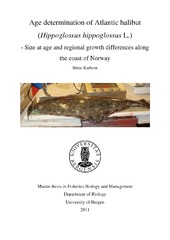Age determination of Atlantic halibut (Hippoglossus hippoglossus L.) - Size at age and regional growth differences along the coast of Norway
Abstract
The traditional method for estimating age of Atlantic halibut (Hippoglossus hippoglossus) is through surface readings. Previous studies have not been compared to find the best practice for surface reading techniques. Based on experiments with different preparation treatments and techniques, this study establishes an updated procedure for the age determination of Atlantic halibut. The study also show a significant difference between age interpretations made after the former method previously used by the Institute of Marine Research (IMR), and the updated procedure, indicating either under- or overestimation of ages respectively. The timing of seasonal zone formation varies between species. This study confirms that in Atlantic halibut, the opaque increments are deposited during summer, while the translucent increments are formed during winter. The length and weight relationship, and the relationship between size and age, are described using data collected along the Norwegian coast. The differential growth between male and female halibut that has been found in previous works is confirmed. Regional size differences, consistent with previous findings, are demonstrated for different latitudes, with larger individuals distributed at the higher latitudes. The expenses and difficulties related to age determination of fish make the application of length and weight distributions for age estimation an attractive choice. This study attempts to construct an age-length-weight key based on length and weight data collected in the time period 2004-2006 and 2008-2010, and on the ages interpreted for the corresponding otoliths.
